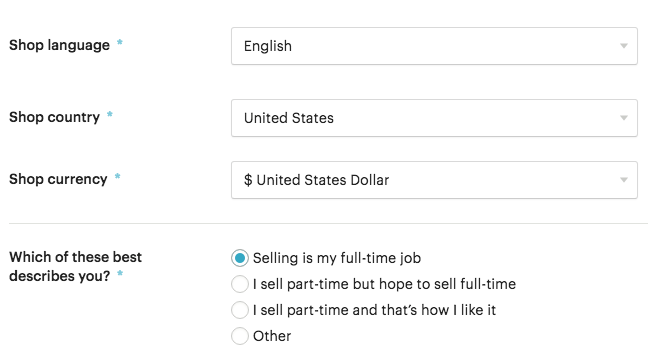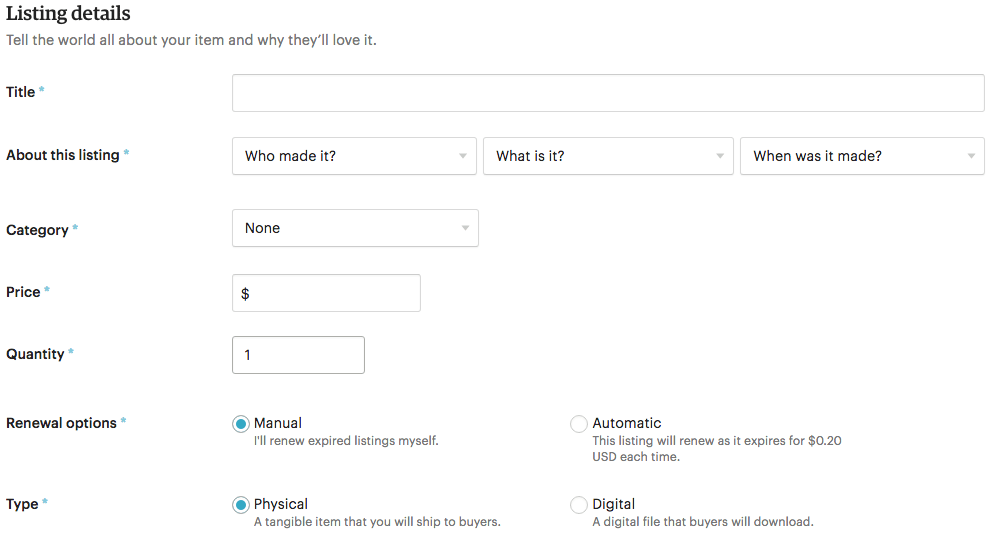Congratulations! You have really gone and done it! You went out there with an idea, a thought, with nothing more than hope in hand and confidence in spirit. This original idea was far from perfect, but the birth of a t-shirt was officially underway. The artist boiling inside of you sketched and outlined and drew up a design, putting pen to paper and watching your idea come to life. You ordered them and printed them, but now they’re just sitting in boxes around your cramped apartment. So your abstract idea is a tangible reality, but now what?
Sell, sell, sell! You want to watch your merchandise fly out of those cardboard boxes and onto people’s backs around the world (or even better, the galaxy). But you may ask, “TeeHunter, however will I sell such glorious t-shirts?” And do we have a solution for you. Introducing… *cue fanfare*
Etsy! A knight in shining armor has arrived, and his listing fee is less than a quarter. But why sell on Etsy? It often sounds, looks, and smells just like Amazon, Craigslist, or practically any other marketplace sort of website. It definitely has its pros and cons, but in the end, you make the final decision.
Setting Up Shop
For starters, Etsy lets you register and open a store for free! It is very user friendly and helpful, and it is touted as “fantastic for talented artists… to share their work with the world and actually get a chance to sell it” by Ashley, a reviewer from Kansas City, Missouri, and a “great little site for [a] quirky kind of goods” by another from Syracuse, New York. From promotion on social media to personalization with each store, Etsy allows sellers to utilize special tools to manage your business effectively and interact with customers seamlessly. The site specializes in fresh sellers, and it does the best it of its ability to guide and nurture your business to success.
After you’ve opened your store, there is a tiny $0.20 listing fee for an item, a small price to pay for so much opportunity. You list your own price, upload a few photos, and bam! You’re in business. Once buyers start making their move, Etsy gets just over 3% of the profits (plus another 3% processing fee), and you get to keep the rest. Plus, every transaction is protected with fraud security around the clock, so you know the money will never fall into the wrong hands. Package your shirts, ship them off, and onto the next customer. It’s all as easy as that. However between customer service and manufacturing, Etsy has had some notable issues with buyers and sellers alike. But we’ll get to those in a bit. First, let’s go into a little more detail on how it all works.
Stocking the Shelves
First things first, head over to etsy.com. Yeah it’s a good start, I know. Once you’re on the homepage, click “Register” in the top right hand corner, and it will bring you to this easy dialog:

Fill out the info, but be careful with the username because it cannot be changed. After you fill everything out, it will send you a confirmation email, so make sure to check your inbox and click on the link. Now you’re officially registered, hooray!
Next, you need to become an official seller. Once you’re signed in, go to the top right corner again, and click “Your Shop.” It will bring you to an easy, five-step process that will establish your shop and get you on the market. You need to declare your shop’s language, country, and currency (for pretty obvious reasons), then you have to decide what type of seller you are.

Next, you get to choose your shop’s name. This is pretty straightforward if you are already selling with an established brand. But what if your entire company consists of you as founder, CEO, financial manager, assistant designer, and anything else you can fit on one business card? You’ve got to get creative! Etsy recommends that a “good shop name should be easy for people to understand and remember.” It can be obvious or weird, long or short… you decide! Personally, I think you can never go wrong with a good pun.
Now it’s time for the real, solid stuff: actually selling your shirts! Click “Add a listing” in the blue box, and suddenly an avalanche of empty boxes and pictures and questions begins to tumble down the mountain towards you.




All this and more may be a bit overwhelming at first, but I promise they are not as bad as they look. Each little detail has tips and hints, and some parts have entire separate pages dedicated to helping you. Take it slowly and carefully, and make sure you’re not biting off more than you can chew. It would look really nice to list your shipping time as a single day… but a buyer might be more than a little upset if you can’t actually fulfill your promise. If you are just starting out (and especially if selling t-shirts is not your only job), it is wise to err on the side of caution.
Another helpful hint: make it personal! That is why people use Etsy after all; between the handmade goods and the young vibe, Etsy has made its fortune off of genuine human connection. So when you write the description, include your inspiration for the design or your personal favorite part of the shirt. You want customers to know that there is an actual hardworking person behind each and every t-shirt. List as many items as you can (while maintaining top quality), and don’t forget to double-check everything!

Finally, you get to dip your toes into the financial side of things. Between payment and billing, here is another avalanche of boxes, another avalanche of boxes that you cannot mess up. These last two steps deal with some pretty important digits, including your Social Security Number, bank account, and address. Again, it looks intimidating. But just take it one section at a time, and the pain will be over before you know it.
And just like that, you’ll have your shirts ready and waiting for the world to love. And it doesn’t end there! Beyond simply hosting shops, Etsy continues to have helpful pages along the way to guide and explain.

Keeping a Wary Eye
Like I mentioned earlier, Etsy sure is nice, but it is far from perfect. Across the web, there are hundreds (if not thousands) decrying Etsy as a sham and rip-off. Though the most controversial issues primarily affect buyers, sellers are involved as well. ConsumerAffairs awards Etsy an impressive single star out of a potential five. Both Trustpilot and ResellerRatings give it about a 4 out of 10; however, SiteJabber seems a little more conflicted with a 66%. Altogether, the reviews look pretty polarized, taking one side of the spectrum or the other with not much in terms of middle ground.
Most negative reviews regard Etsy as untrustworthy with awful customer service. Generally, the reviews start with a tirade against the original seller, but they soon expand, claiming Etsy protects its sellers to exploit their customers. Others go further, accusing the site of harming small businesses and repeatedly infringing on copyright.


In stark contrast, positive reviews applaud Etsy for their diversity and for their affordable prices. Many caution buyers of shady sellers but do not have anything bad to say about the platform itself.


Although the negative reviews are in a (marginal) minority, it still looks like a gamble. Every site has its faithful and its foes, but Etsy’s foes seem to be a bit more outspoken. In the end, do your research, and make the smart choice for you. But one way or another, one thing is absolutely for certain: get your shirts out there!
Do you disagree? Are you an Etsy diehard, or would you rather die than use Etsy? We want to hear what you think, so comment below!


